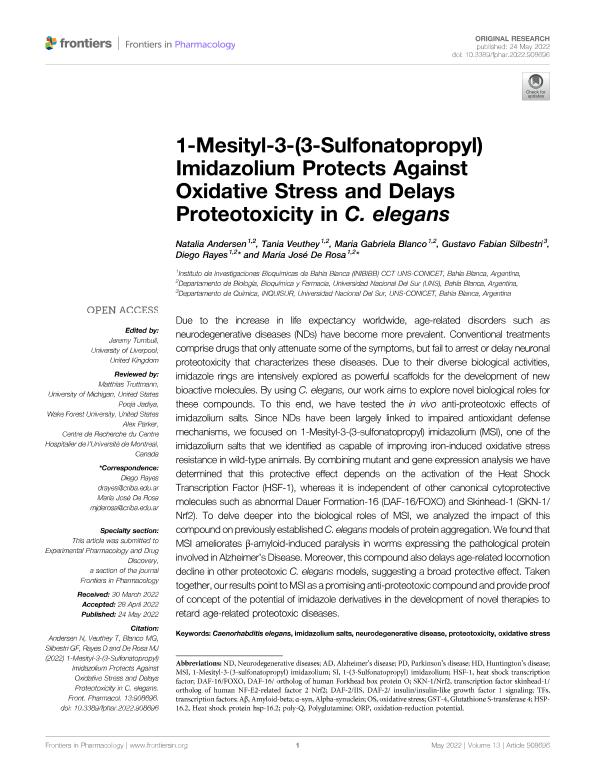Mostrar el registro sencillo del ítem
dc.contributor.author
Andersen, Natalia Denise

dc.contributor.author
Veuthey, Tania Vanesa

dc.contributor.author
Blanco, Maria Gabriela

dc.contributor.author
Silbestri, Gustavo Fabián

dc.contributor.author
Rayes, Diego Hernán

dc.contributor.author
de Rosa, Maria Jose

dc.date.available
2023-04-28T15:59:26Z
dc.date.issued
2022-05-24
dc.identifier.citation
Andersen, Natalia Denise; Veuthey, Tania Vanesa; Blanco, Maria Gabriela; Silbestri, Gustavo Fabián; Rayes, Diego Hernán; et al.; 1-Mesityl-3-(3-Sulfonatopropyl) Imidazolium Protects Against Oxidative Stress and Delays Proteotoxicity in C. elegans; Frontiers Media; Frontiers in Pharmacology; 13; 24-5-2022; 1-17
dc.identifier.issn
1663-9812
dc.identifier.uri
http://hdl.handle.net/11336/195812
dc.description.abstract
Due to the increase in life expectancy worldwide, age-related disorders such as neurodegenerative diseases (NDs) have become more prevalent. Conventional treatments comprise drugs that only attenuate some of the symptoms, but fail to arrest or delay neuronal proteotoxicity that characterizes these diseases. Due to their diverse biological activities, imidazole rings are intensively explored as powerful scaffolds for the development of new bioactive molecules. By using C. elegans, our work aims to explore novel biological roles for these compounds. To this end, we have tested the in vivo anti-proteotoxic effects of imidazolium salts. Since NDs have been largely linked to impaired antioxidant defense mechanisms, we focused on 1-Mesityl-3-(3-sulfonatopropyl) imidazolium (MSI), one of the imidazolium salts that we identified as capable of improving iron-induced oxidative stress resistance in wild-type animals. By combining mutant and gene expression analysis we have determined that this protective effect depends on the activation of the Heat Shock Transcription Factor (HSF-1), whereas it is independent of other canonical cytoprotective molecules such as abnormal Dauer Formation-16 (DAF-16/FOXO) and Skinhead-1 (SKN-1/Nrf2). To delve deeper into the biological roles of MSI, we analyzed the impact of this compound on previously established C. elegans models of protein aggregation. We found that MSI ameliorates β-amyloid-induced paralysis in worms expressing the pathological protein involved in Alzheimer’s Disease. Moreover, this compound also delays age-related locomotion decline in other proteotoxic C. elegans models, suggesting a broad protective effect. Taken together, our results point to MSI as a promising anti-proteotoxic compound and provide proof of concept of the potential of imidazole derivatives in the development of novel therapies to retard age-related proteotoxic diseases.
dc.format
application/pdf
dc.language.iso
eng
dc.publisher
Frontiers Media

dc.rights
info:eu-repo/semantics/openAccess
dc.rights.uri
https://creativecommons.org/licenses/by-nc-sa/2.5/ar/
dc.subject
CAENORHABDITIS ELEGANS
dc.subject
IMIDAZOLIUM SALTS
dc.subject
NEURODEGENERATIVE DISEASE
dc.subject
OXIDATIVE STRESS
dc.subject
PROTEOTOXICITY
dc.subject.classification
Otras Ciencias Biológicas

dc.subject.classification
Ciencias Biológicas

dc.subject.classification
CIENCIAS NATURALES Y EXACTAS

dc.title
1-Mesityl-3-(3-Sulfonatopropyl) Imidazolium Protects Against Oxidative Stress and Delays Proteotoxicity in C. elegans
dc.type
info:eu-repo/semantics/article
dc.type
info:ar-repo/semantics/artículo
dc.type
info:eu-repo/semantics/publishedVersion
dc.date.updated
2023-04-27T18:30:51Z
dc.journal.volume
13
dc.journal.pagination
1-17
dc.journal.pais
Reino Unido

dc.journal.ciudad
London
dc.description.fil
Fil: Andersen, Natalia Denise. Consejo Nacional de Investigaciones Científicas y Técnicas. Centro Científico Tecnológico Conicet - Bahía Blanca. Instituto de Investigaciones Bioquímicas de Bahía Blanca. Universidad Nacional del Sur. Instituto de Investigaciones Bioquímicas de Bahía Blanca; Argentina. Universidad Nacional del Sur. Departamento de Biología, Bioquímica y Farmacia; Argentina
dc.description.fil
Fil: Veuthey, Tania Vanesa. Consejo Nacional de Investigaciones Científicas y Técnicas. Centro Científico Tecnológico Conicet - Bahía Blanca. Instituto de Investigaciones Bioquímicas de Bahía Blanca. Universidad Nacional del Sur. Instituto de Investigaciones Bioquímicas de Bahía Blanca; Argentina. Universidad Nacional del Sur. Departamento de Biología, Bioquímica y Farmacia; Argentina
dc.description.fil
Fil: Blanco, Maria Gabriela. Consejo Nacional de Investigaciones Científicas y Técnicas. Centro Científico Tecnológico Conicet - Bahía Blanca. Instituto de Investigaciones Bioquímicas de Bahía Blanca. Universidad Nacional del Sur. Instituto de Investigaciones Bioquímicas de Bahía Blanca; Argentina. Universidad Nacional del Sur. Departamento de Biología, Bioquímica y Farmacia; Argentina
dc.description.fil
Fil: Silbestri, Gustavo Fabián. Consejo Nacional de Investigaciones Científicas y Técnicas. Centro Científico Tecnológico Conicet - Bahía Blanca. Instituto de Química del Sur. Universidad Nacional del Sur. Departamento de Química. Instituto de Química del Sur; Argentina
dc.description.fil
Fil: Rayes, Diego Hernán. Consejo Nacional de Investigaciones Científicas y Técnicas. Centro Científico Tecnológico Conicet - Bahía Blanca. Instituto de Investigaciones Bioquímicas de Bahía Blanca. Universidad Nacional del Sur. Instituto de Investigaciones Bioquímicas de Bahía Blanca; Argentina. Universidad Nacional del Sur. Departamento de Biología, Bioquímica y Farmacia; Argentina
dc.description.fil
Fil: de Rosa, Maria Jose. Consejo Nacional de Investigaciones Científicas y Técnicas. Centro Científico Tecnológico Conicet - Bahía Blanca. Instituto de Investigaciones Bioquímicas de Bahía Blanca. Universidad Nacional del Sur. Instituto de Investigaciones Bioquímicas de Bahía Blanca; Argentina. Universidad Nacional del Sur. Departamento de Biología, Bioquímica y Farmacia; Argentina
dc.journal.title
Frontiers in Pharmacology
dc.relation.alternativeid
info:eu-repo/semantics/altIdentifier/url/https://www.frontiersin.org/articles/10.3389/fphar.2022.908696/full
dc.relation.alternativeid
info:eu-repo/semantics/altIdentifier/doi/http://dx.doi.org/10.3389/fphar.2022.908696
Archivos asociados
